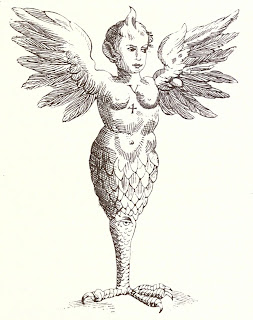Welcome to my latest blog post. Last week I discussed beliefs held about disabled people in the Medieval Period. I did this by examining some of the work of Bede the Venerable. I know what you are thinking, the Medieval Period pretty much spanned a thousand years, how can you draw conclusions by looking at the work of one guy? The short answer is, you can’t. However, the Middle Ages were always a weak point of mine and there are areas I find more appealing. Speaking of which, welcome to the world of monsters!
What is a Monster?
Okay. This post could go on for a while with all my ramblings, so I will try and get to the point quicker than usual…. or maybe not. When I think of monsters, I think of creatures that are both frightening and ugly. Well, I suppose they could also act in horrible ways, but that is not my immediate thought. The English word monster actually comes from the Latin “monstra” which means to show or demonstrate. Therefore, someone who was deemed to be a monster was an indication of something that was happening at that time or foretold an event in the future. If they were indications of a future event, they were known as prodigies. These beliefs were popular in the Middle Ages, but reached their peak in the 16th Century. Any child born with a deformity was viewed as a monster, due to the peculiarity of their appearance. Therefore, any incidence of that nature became known as a monstrous birth.
The Monster of Ravenna
Perhaps the best example on a monstrous birth comes from Italy in the early 1500’s. The dates and locations of the event tend to change, but the overall story stays the same. There was a child born that had so many deformities they were thought of as a monster. A pharmacist from Florence (ooh…. that rhymes), who saw an image of the child, described it as follows:
‘It had a horn on its head, straight up like a sword, and instead of arms it had two wings like a bat’s, and at the height of the breasts it had a fio [Y-shaped mark] on one side and a cross on the other, and lower down at the waist, two serpents. It was a hermaphrodite, and on the right knee it had an eye, and its left foot was like an eagle’s’.
As you can see there were several unusual aspects to this child. Some of them are very farfetched. Due to this account, which circulated quickly thanks to the recent development of mass printing, people believed the child was from Florence. As the story spread, the child’s origins and deformities changed. It was even rumoured that it was the offspring of a nun and a friar.
The child is commonly known as The Monster of Ravenna. This is because it has been suggested that the birth occurred in 1512 in the Italian city of Ravenna. This may just be an indication that the child was an omen of disaster to come. You see, just a few weeks after the reported birth of this ‘monster’, Ravenna was sacked by combined Papal, Spanish, and French forces. They must really not have liked that city! It is most likely that the time and location of the child’s birth were changed to account for the destruction of the city.
Could the Monster of Ravenna Have Been Real?
Okay, I know it may sound strange, but the Monster of Ravenna was more than likely a real child. Granted, certain aspects of its appearance were embellished as the story circulated, but they were based in fact. It has been suggested that the bat or bird wings could have been underdeveloped arms. Similarly, eagle feet may have been a description of missing toes as well as club foot. As for the fact that the child was a hermaphrodite, it is possible that its body was not fully formed, making it impossible to identify the gender. Many of these characteristics can be found in Roberts Syndrome. Unfortunately, Pope Julius II ordered for the child to be starved to death.
On that cheery note, I think it is time to end. I know it’s probably not the happiest of topics, but I’m always fascinated by how various cultures from different periods react to disability.
To keep up to date with my latest blog posts, you can like my Facebook page, or follow me on Twitter. You can find them by clicking the relevant icons in the sidebar.
Next time I hope to discuss the idea of maternal impression in greater detail.
The Wheelchair Historian
Further Reading
Bates, Alan W., Bates, Tony, ‘Emblematic Monsters: Unnatural Conceptions and Deformed Births in Early Modern Europe’, (Rodopi, 2005) Google Books.
CandyGuyTHE MONSTER OF RAVENNA’ https://www.thehumanmarvels.com/the-monster-of-ravenna/ Accessed: 5th February 2021.
Eamon, William, ‘The Monster of Ravenna’, April 11, 2011 https://williameamon.com/?p=707 Accessed: 5th February 2021.
Walton MT, Fineman RM, Walton PJ. ‘Of monsters and prodigies: the interpretation of birth defects in the sixteenth century’. Am J Med Genet. 1993 Aug 1;47(1):7-13. doi: 10.1002/ajmg.1320470103. PMID: 8368257.

No comments:
Post a Comment